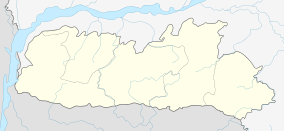Nokrek National Park
| Nokrek National Park | |
|---|---|
| Nokrek Biosphere Reserve | |
|
IUCN category II (national park) | |
  | |
| Location | West Garo Hills district, Meghalaya, India |
| Nearest city | Willim Nagar, Tura |
| Coordinates | 25°32′N 90°7′E / 25.533°N 90.117°ECoordinates: 25°32′N 90°7′E / 25.533°N 90.117°E |
| Area | 47.48 square kilometres (18.33 sq mi) |
Nokrek National Park, or Nokrek Biosphere Reserve, is a national park located Approximately 2 km from Tura Peak in West Garo Hills district of Meghalaya, India. UNESCO added this National park to its list of Biosphere Reserves in May 2009.[1][2] Along with Balphakram national park, Nokrek is a hotspot of biodiversity in Meghalaya.[3]
Nokrek has a remnant population of the Red panda that has generated curiosity across the world. One was accidentally shot by Dr J. Lao in 1960s.[4][5] Nokrek is also an important habitat of the Asian elephants.[6] The park had eight species of cats, ranging from Tiger to Marbled cat but the current status of the former is uncertain.[7]
There are seven species of primates in Nokrek. The rare Stump-tailed macaque is frequently seen near the main trek to the peak.[8] The Pig-tailed macaque also occurs.[9] Hoolocks are common and their calls could be heard all over Nokrek.[10]
Nokrek is also an Important Bird Area.[11][12]
There is a vast range of plants found in the park. A virgin canopy of thick, tall and lush green forests cover Nokrek and its environs. The mother germoplasm of Citrus indica (locally known as Memang Narang) have been discovered by science researchers within Nokrek Range. This discovery led to the establishment of the National Citrus Gene Sanctuary-cum-Biosphere Reserve covering an area of forty-seven square kilometres.The area is noted for its wild varieties of citrus fruits that provide a gene-pool for commercially produced citrus.
The entire Biosphere Reserve is hilly. The rock is mainly gneisses, granulites, migmatites, amphibolites and banded iron formation, intruded by basis and ultra-basic bodies. In most of the Biosphere Reserve area the soil is red loam. But sometimes it varies from clayey to sandy loam. The soils in the Biosphere Reserve are rich in organic matter and nitrogen but deficient in phosphate and potash. The area consists of patchy sedimentary rock composed of pebble bed, sand stone, and carbonaceous shales.
All important rivers and streams of the Garo Hills region rise from the Nokrek Range, of which the river Simsang, known as Someshwari when it emerges into Bangladesh at Baghmara, is the most prominent.
Famous sites in the park include the famous Nokrek Peak, Rongbang Dare Water Fall.
Balpakram National Park and the famous Siju Cave is located very close to the Napak Lake near the Simsang River game reserve which is south east to Nokrek National Park. The Cave is filled with water and is miles long.
See also
References
- ↑ "Three Indian sites added to UNESCO list of biosphere reserves". Sify. 27 May 2009. Retrieved 2009-05-30.
- ↑ "UNESCO Designates 22 New Biosphere Reserves". Environment News Service. 27 May 2009. Retrieved 2009-05-30.
- ↑ Choudhury, A.U. (2003). Meghalaya's vanishing wilderness. Sanctuary Asia 23(5): 30-35.
- ↑ Choudhury, A.U. (1996). Red panda in Garo Hills. Environ IV(I): 21.
- ↑ Choudhury, A.U. (2001). An overview of the status and conservation of the red panda Ailurus fulgens in India, with reference to its global status. Oryx 35(3):250-259.
- ↑ Choudhury, A.U. (1999). Status and conservation of the Asian elephant Elephas maximus in north-eastern India. Mammal Review 29(3): 141-173.
- ↑ Choudhury, A.U. (2003). The cats in North East India. Cat News 39:15-19.
- ↑ Choudhury, A.U. (2002). Status and conservation of the stump-tailed macaque Macaca arctoides in India. Primate Report. 63: 63-72.
- ↑ Choudhury, A.U. (2003). The pig-tailed macaque Macaca nemestrina in India - status and conservation. Primate Conservation 19:91-94.
- ↑ Choudhury, A.U. (2006). The distribution and status of hoolock gibbon, Hoolock hoolock, in Manipur, Meghalaya, Mizoram and Nagaland in Northeast India. Primate Conservation 20: 79-87.
- ↑ Islam, Z. & rahmani, A. (2004). IBAs in India. BNHS & BirdLife Int., Mumbai & Cambridge
- ↑ Choudhury, A.U. (2010). Nokrek national park – an IBA in Meghalaya. Mistnet 11 (1): 7-8.
External links
- India Wildlife Resorts - Nokrek National Park
- Exotique Expeditions - Nokrek National Park
- WebIndia123 - National parks of Meghalaya